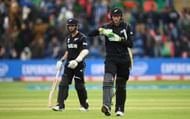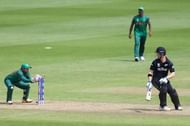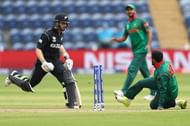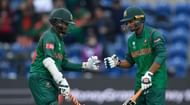After a damp start to the tournament, the Champions Trophy suddenly sprung to life in the past couple of days with the slightly unexpected victories of Pakistan over South Africa and Sri Lanka over India.
With the format of the tournament offering minimal margin for error and a few rain-marred games in between, the last leg of the group stage matches had set themselves up as exciting knockout clashes.
In the first of those clashes in Group A, New Zealand took on Bangladesh in Cardiff. The Kiwis had tasted defeat against the latter in a tri-series, also involving Ireland, few days prior to the tournament and would have been wary of their opposition going into the must-win encounter.
Their worst fears came true at the end of the match, when Bangladesh scripted an epic come-from-behind victory to knock them out of the tournament.
Opting to bat first, New Zealand could scrape through to a total of 265 only, less than par in these conditions. Yet, their hopes would have brightened after a brilliant spell with the new ball from Tim Southee reduced the opposition to 12/3 in the 5th over.
However, that was all for New Zealand in the game as Shakib Al Hasan and Mahmudullah stitched together a record partnership, taking Bangladesh past the target quite nonchalantly. As being the first team to be knocked out would suggest, nothing has gone right for the Kiwis through their short campaign.
Here are five things that went wrong for them in this virtual knockout against Bangladesh.
#1 Openers disappoint again

Primary to New Zealand’s woes in the tournament has been the indifferent form of its openers, that has put added responsibility on the shoulders of Kane Williamson.
Opener Martin Guptill, a vital cog in their limited overs team, has had a lean patch in the tournament. In each of the three games, the opener got off to starts – scores of 26, 27 and 33 – before throwing his wicket away. This, after a hard-hitting 116 against Sri Lanka in the warm-ups.
At the other end, Luke Ronchi started impressively with a couple of 60s in the warm-up against India and in New Zealand’s opening game against Australia but faded away with a golden duck against England and 16 here against England.
Against Bangladesh, the duo started solidly and added 46 for the first wicket before Ronchi mistimed a shot to mid-on. Not much later, Guptill was trapped plumb in front of the stumps by Rubel Hossain. While the openers did get off to a start, New Zealand would have expected both to convert their starts into longer innings.
This would have ensured New Zealand scored much more than just 265.
#2 Underperforming all-rounders

With the failures of his opening batsmen, much has hinged on Kane Williamson, who has had to single-handedly rebuild the innings and carry New Zealand into competitive scores in each of the games. With the exception of Ross Taylor, the lack of support from the batsmen around him hasn’t helped matters for captain.
The out-of-form Neil Broom is the only other specialist batsman in the team and the middle order has in its ranks, the trio of Corey Anderson, James Neesham and Mitchell Santner – who have all failed to live up to potential with bat and ball.
Left arm spinner Santner scored just 25 runs in three innings and picked his only wicket against England; Neesham scored 47 and went wicket-less, and Corey Anderson, notwithstanding the three-wicket haul against England, came a cropper as far as his batting is concerned, scoring a paltry 18 runs across three innings.
Against Bangladesh, Anderson was out for a first ball duck. Neesham contributed a run-a-ball 23 with the bat but proved expensive with the ball, conceding 30 in his four overs. While Santner scored an unbeaten 14 and bowled tidily, he couldn’t give the breakthroughs New Zealand needed, to close out the game after Southee’s spell.
The collective failure of its all-rounder trio is one major reason why New Zealand have gone down in the tournament.
#3 Williamson’s runout

After the loss of both the openers, New Zealand’s best two – Williamson and Taylor – got their heads down to the task of consolidating the innings. The duo added 83 for the third wicket and scored at just less than 5 per over. However, at 152, off the final delivery of the 30th over, a terrible mix-up saw the captain running himself out while going for a non-existent run.
Williamson, batting on 57, had been in stellar form, with scores of 100 and 87 against Australia and England, and was well set for another big one. Had he stayed on and the fruitful association with Taylor continued, the two set batsmen would have capitalised on their starts and definitely pushed the score closer to 300.
#4 Not getting a move on
In spite of Williamson’s dismissal, the Kiwis had done enough by then to double their score in the 30th over. Yet, between this incident and the end of the innings, New Zealand could manage to add only 113 more to their score in the remaining 20 overs.
The solid foundation laid by Williamson and Taylor was not capitalised on as the Kiwis never got a move on in the latter half of their innings. Ross Taylor, who was batting on 44 at the time of Williamson’s dismissal, departed after adding just 19 more to his tally in his next 24 deliveries.
Though the Kiwis played out the full 50 overs, regular fall of wickets meant none of the remaining batsmen was able to settle in and push the scoring rates in the slog overs.
#5 Wasted start with the ball

If New Zealand required anything to compensate for their under-par score, it was a few wickets at the start. That’s exactly what Tim Southee delivered in his opening spell, plucking out the Bangladesh top-order for next to nothing with three overs of brilliant swing bowling that yielded as many wickets.
His first victim was the in-form Tamim Iqbal, trapped plumb in front for a duck by a ball delivered full on middle stump and swinging into leg. Off his next over, he sent back Sabbir Rahman with one that pitched just outside off and swung away with an edge to Ronchi.
In a similar fashion to Tamim’s dismissal, fellow opener Soumya Sarkar was also hit on the pads by one that swung in and Bangladesh were reeling at 12/3 at the end of Southee’s third over. With such a start, most people would have written off Bangladesh’s ability to pull out of misery and script an epic, especially when they had lost their premier batsman Tamim Iqbal, who had scored 223 runs, including a century against England and 95 against Australia.
Shakib and Mahmudullah had other ideas. Mushfiqur Rahim’s departure off a 146km/h ripper from Milne brought the duo together at the crease. The pair then followed the footsteps of their Sri Lankan middle order counterparts in not being rushed by scoreboard pressure and sticking to the basics of playing the ball on merit and slowly building the chase.
In a record 224-run partnership – Bangladesh’s highest ever in ODIs – Shakib and Mahmudullah batted Kiwis out of the game with a sensible display of batting. Once the new ball wore off and the change bowlers came on, the Kiwi bowling attack was rendered toothless.

